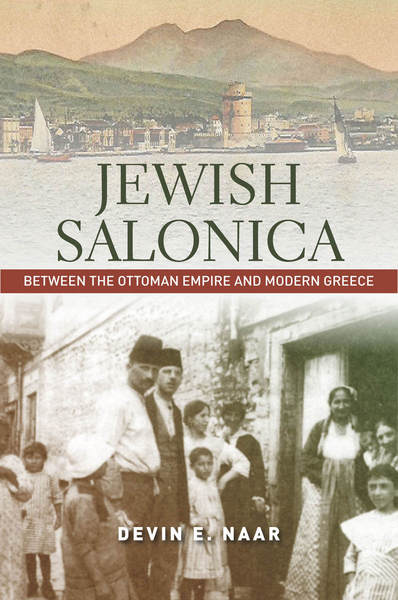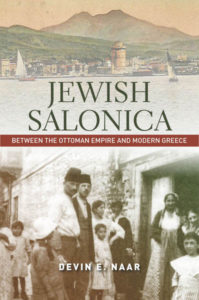
 This is part of our special feature, Contemporary Urban Research in the European City.
This is part of our special feature, Contemporary Urban Research in the European City.
Jewish Salonica is a cornerstone of Sephardi legacy, without which it is impossible to describe the history of Sephardi Jews after their expulsion from the Iberian Peninsula. Alongside Istanbul, Salonica stands at the center of the study on Ottoman Jewry and the Jewish Sephardi Diaspora. This established community, in its last fifty years of existence, is the subject of the book by Devin E. Naar. During this age, the Jews of Salonica transformed from living as equal subjects in the realms of the Ottoman sultans – without idealizing the Ottoman past – to living in the Greek Christian nation state. For about three decades, the Salonican Jews lived under the Greek state, and as Naar claims, when moving to the Greek state (1912) “rather than transporting themselves to a different country, a different country had come to them” (5). The Jews’ path towards modernity was gradual not necessarily a linear path.
In 1943, the community was eradicated, and only several thousand Jews returned to live in Salonica following WWII. The foretold ending shadows the entire book, leaving the reader with a troubling sensation. Not only were fifty thousand people murdered, but all that was left behind – physical evidence, the dozens synagogues, public institutes, houses and the enormous cemetery – was demolished by the Greeks who participated in the destruction and looting.
The community’s annihilation did not start with the Nazi occupation. In many senses, Salonica’s fall to Greek hands signaled the end of the old world. But the larger markers were the end of WWI, the traumatic fire of 1917 and the 1923 Population Exchange between Turkey and Greece. Not only have the Jews lost the relatively convenient Ottoman rule, under which they had lived for hundreds of years, and lost in the fire much of their written heritage; now they also lost the advantage as a majority. They were forced to cope with laws and regulations initiated by the state, aimed at strengthening the Hellenic character of the country. These laws damaged their communal, religious, commercial and everyday conduct. The Jewish economy, severely harmed by the cut-off from the old imperial apparatus, was damaged further when the government preferred to nominate Piraeus, the capital city’s port, as the most important Greek port.
Naar attempted to draw in his book the image of the Salonican community in the last decade of the nineteenth century – the end of the Hamidian Period in the Ottoman Empire, until the community’s destruction in 1943. In his book, the author seeks to answer this main question: “How […] did the transition from Ottoman to Greek sovereignty impact Jewish society; and how did Jews varyingly embrace, resist, and negotiate the process both as individuals and as a collective?” (XIV). Naar also probes “the legacies of the cultural, legal, and political practices of the late Ottoman Empire on the consolidating Greek state that reveal the continuing dynamism among the Salonican Jewish society” (6).
Another significant issue we encounter already in the preface of the book is memory construction and the formulation of a myth. Jewish Salonica is known in the collective memory as ‘the Mother of Israel’ (ir va-em be-Israel). This is a highly influential construct. Its influence is apparent both in historiography and in the collective memory of community descendants and all Sephardim. This construct’s formulation paradoxically intensified after the community’s annihilation by the Nazis. In his book, Naar investigates the formulation and creation of this construct from the 1890s to the community’s annihilation.[1] Naar discusses with detail what was so far merely a hunch, or hinted. He reveals the history of image construal – an image that is not necessarily identical to reality.
Naar’s book fits into the current historiographic trends which emphasize the importance of internal processes in the modernization of the Ottoman Empire Jews, as well as their self-agency. I have related (Y.B-N) to this matter elsewhere. This trend persists in Naar’s discussions of the fate of Salonican Jews in the Greek state, where it is even more innovative and refreshing. While others have described this fate as a process of constant, gradual decline, Naar strives “to temper the general thrust of existing studies that highlight the downward spiral of Salonica’s Jews following the city’s incorporation into Greece” (11). Naar stresses that the Salonican Jews should not “be dismissed as passive victims or as disconnected from the realities of their world” (291). To him, Salonican Jews are not only passive victims of Greek anti-Semites or the Nazis, but “historical actors in their own right” (11). According to Naar, the efforts of Salonican Jews to claim a place for themselves within Hellenic state, and the ways in which they, and especially their intellectual elite, imagined Hellenism much as they had imagined Ottomanism: as a supra-communal political identity which they viewed as broad and flexible enough to include not only the dominant communities, but also the non-dominant ones (i.e. Jews).
Naar should be applauded for attempting to relate to the Ottoman-Greek continuum, thereby continuing the tradition of his teacher, Aron Rodrigue, and his colleague, Ester Benbassa.[2] His view provides a broad and significant perspective on that period.
The introduction, titled “Is Salonica Jewish?” deals with the image of Salonica as “the Mother of Israel” and “Jerusalem of the Balkans,” and generally in its central, almost mythical, place in Sephardi legacy. Here, Naar concludes his thoughts about Jewish historiography and its treatment of this community by asking whether this was indeed a sui generis community in the illusions of memory, and the politics of memory and memorialization. Quite a few of the comments about Salonica are relevant for other Jewish communities, making this book fascinating also for those studying Jewish history in general.
The first chapter concerns the communal organization, which was almost a city within a city, a state within a state. Naar makes sure to emphasize that the changes of government and time did not dramatically alter the communal structure, or significantly reduce its importance to the individuals. The community was still very powerful, both by virtue of Greek law and by voluntary acceptance, and was far from dissimilation as one might think. The chapter explains the organizational image of the community, as reformulated in the Tanzimat age, specifically after 1870. It later discusses its metamorphoses under Greek rule and how it continued to be significant in the lives of the Jewish individuals; this, although some of them objected to the power and monopoly of the community and preferred to be Greek citizens in every respect.[3] Naar demonstrates how “The perpetuation of the Jewish Community in Salonica signified the unexpected legacy of millet [ethno-religious group]-style imperial structures, recast in the language of minority rights, in the context of the Greek nation-state” (39).
The second chapter concerns the chief rabbinate. During the 1920s and 1930s, the ideal image of a chief rabbi transformed. Age, pedigree, status or profound rabbinic knowledge were no longer criteria. The community leaders sought after a modern, educated man, someone perceived as “progressive” and “enlightened,” and as a person who can be an appropriate representative and a worthy “partner with the authorities” (134). Ester Benbassa demonstrated that in 1909, similar considerations had led to nominating Haim Nahum (1873-1960), the last chief rabbi of the Ottoman Empire.[4] Few Sephardi rabbis in that time met such strict criteria, and it is no wonder, then, that the rabbi chosen in the 1930s in Salonica was an Ashkenazi, born in Poland, educated in the field of German culture, who wrote a dissertation on the Quran (123).
The third chapter concerns education and the education institutions. As of the last quarter of the nineteenth century, schools were considered to be an incubator for shaping future generations. Upon the early period of the Greek state, the schools were perceived as sites in which children of the last generation of Ottoman Jews were to become the first generation of Hellenic Jews. Schools contributed both to the preservation and transformation of Jewish identity. At the end of the Ottoman Period, the old Jewish education institutes, headed by the prestigious ‘Great Talmud Torah’ had to compete with the modern ones such as Alliance Israélite Universelle and foreign schools. Naar describes the shift in the old educational institutes – now the Great Talmud Torah imported foreign Jewish principals: An Ashkenazi Jew from France, a Western Sephardi of Livorno, and later an Ashkenazi from late Ottoman Palestine. The Greek state, much like the young Turkish Republic, banned the operation of the Alliance chain. Therefore, most of the Greek Salonican Jews studied in Jewish educational institutions, which were increasingly modernized and nationalized by the state. The Greek state even established schools for Jewish children and co-sponsored new textbooks. These institutions preserved the Jewish identity of the students, while emphasizing allegiance to the Greek language, the Hellenic heritage and the Greek state.
The fourth chapter describes and analyzes the work of the local Jewish historians, while the fifth concerns the prolonged struggle to preserve the local Jewish cemetery. We have chosen to elaborate on these two issues. Naar discusses the motivations Salonican Jews had to write the history of Salonican Jewry. Historiography of this kind – as well historiography of general Ottoman Jewry – was hardly written until the 1890s, and only several Ottoman-Jewish Maskilim had historical awareness. [5]However, such writing increased in scope during the half-century Naar relates to. He focuses on five historians operating during that period, mentioned by their characteristic nicknames: “the professor”, Mercado Covo (1874-1940), “the apostle,” Baruch Ben-Jacob (1884-1943), “the mentor,” Joseph Nehama (1880-1971), “a faithful son,” Issac Emmanuel (1896-1972), and “the historian of the future,” Michael Molho (1890-1964).
Naar demonstrates how the research conducted by those five has helped construct Salonica’s memory the “Mother of Israel” and “Jerusalem of the Balkans” (the term ‘Balkan’ was coined only during the Balkan Wars of 1912-1913). At the end of the Ottoman period, emphasis was put on the formulation of Jewish Salonica following the expulsion from Iberia (1492), and it was intensified after the 400th jubilee. In the Greek age, some of the emphasis was put on the early history of Salonica and its Jewry, during the first centuries AD, and the Romaniote Jewish existence in this city, alongside the Greek Christian one. This study stresses the autochthonous nature of the Jews and their Hellenic identity, while serving their claim to an equal status in the new setting. These writers and others desired to create a world in which, in the words of the New Testament, “there is neither Jew nor Greek” (Galatians 3:28).
The Iberian matter remained significant. Some historians underscored their connection to the Sephardi culture, sometimes also their connection to modern Spain and its language. The most prominent among them, Nehama, even became a Spanish citizen, an act that in retrospect saved him from death during the holocaust (219).
The methodological importance of discussing historiography lies in the fact that Naar does not only focus on analyzing their work but continues to characterize them as a distinct social group: these historians received rabbinical training, most of them served as rabbis or cantors, and they maintained a religious lifestyle in an age of growing secularization (236). Naar’s findings in this matter correspond to Tamir Karkason’s findings with respect to Jewish Maskilim (enlighteners) in the Ottoman Empire. The Salonican historians, like some of their colleagues in Mandatory Palestine, can be defined as “late Maskilim” with a link to the late Jewish Haskalah movement and for some also a link to the realm of the Wissenschaft des Judentums (Judaic Studies) movement. Emanuel even studied in the Rabbinical Seminar of Breslau, and Naar depicts his life as a sole “Oriental Jew” among Ashkenazi brethren in the 1920s ( 219-225).
Therefore, this chapter fills a lacuna in the study, being one of the first studies published about the historiography of the Ottoman Empire Jews. However, unlike Naar’s important paper mentioned above, this chapter only deals of the Jewish-Salonican historiography. It hardly relates to the historiographic project conducted in those same years in other nation states that succeeded the Ottoman Empire. Such historiography was led by Shlomo Abraham Rosanes (1862-1938) in Bulgaria and Abraham Galanté (1873-1961) in the Turkish Republic. These two composed works that were just as impressive, and were worthy of comparative reference.
The fifth chapter discusses the enormous Jewish cemetery, probably the largest in the world at the time, containing some three hundred and fifty thousand headstones. Alongside the sentimental and historical value, the writings on these headstones were an important source for studying the community’s and its notables. When the city was re-planned after the fire of 1917, different bodies – the university, neighboring quarters and more – coveted the land. Shortly beforehand, the municipality eradicated the Muslim cemetery of the Sabbatean Ma’aminim (Dönme; on which Marc D. Baer wrote extensively), and now it wished to remove this annoyance also as part of Hellenizing the urban space.
Naar’s discussion of the cemetery is instructive and important, among else since the debate over the cemetery’s fate reflects the intrigues in the community and its relations with the Greek state. The community simultaneously struggled for its past and Sephardi identity, and for integration in the Greek society. As the pressure on the community to deliver the cemetery land to the municipality and the university increased, the Jewish front against it disseminated. Among the reasons for letting the property go: lack of sentiments for the past, disregard of the religious aspect of destroying the cemetery, the notion that being good neighbors requires compliance with the repeating demands to evacuate the land, and concern that refusal might enhance hatred and perhaps lead to renewed physical violence. Almost paradoxically, the pressure to eliminate the cemetery led to increased interest in it in the Jewish journalism, and to documenting the headstones.
The picture drawn by Naar for the first time out of a variety of sources is instructive and fascinating. Despite its weakness, and although being pushed aside, the community’s leadership was able to face the pressure from the municipal authorities, the chamber of commerce, the university and others, both in the days of Venizelos and of Metaxas. The community was aided by various forces within the city and in Athens, and also recruited international Jewish and non-Jewish forces, managing to prevent the expropriation of the land until a law in this respect was enacted in 1936. The window of opportunity opened in WWII, when the Nazis accepted the request of the locals and allowed eliminating the ancient cemetery.
Several concluding notes: at the end of the book is a conclusion, followed by an index that can help the readers focus of a certain matter, image or institute. Greater effort in a more detailed index would have been helpful. For example, it is strange that items such as “anti-Semitism” or “Zionism” have such little reference, “Palestine” has none, and while JQR is mentioned, there is no reference to “Jewish press” or “Jewish journalism.”
The book neglects to mention some of the important contributions of Minna Rozen and her students in various issues, among them economic occupations (the field of Orly K. Meron and Shay Serugo), material culture and consumption as expressions of modernity and Hellenization processes.
The book indeed refers to the Ottoman-Greek continuum, but clearly focuses more on the Greek state period than on the Ottoman period, probably due to his choice of sources. For example, in the chapter concerning education, only 18 pages (pp. 139-156) deal with the Ottoman period, while twice as much (pp. 156-186) discuss the Greek state period. Naar’s new findings of the Greek state period are many and significant, and fill substantial gaps in the field – but from the point of view of Ottomanists, this is somewhat of a miss. These few reservations aside, the book completes significant gaps in Mark Mazower’s book, who wished to encompass the history of Salonica.[6]
Naar’s innovative book constitutes a substantial contribution to the Sephardi studies and fills countless gaps, specifically with respect to Salonica under Greek rule. Naar’s longing to his ancestral city, as noted in his sentimental preface (pp. xvii-xxi), did not diminish from his ability to precisely draw the image of this important and divided community in the eve of its existence, while stressing the liveliness and vitality expressed by this community and its institutions until transported to death. Naar both explains and analyzes various subjects while giving the political background within the community and in its surroundings, and demonstrates how the mythic image of Salonica was constructed, even reinforced as the real community got further away from its glorious past and ‘post mortem’.
Naar erected a fabulous tombstone for Salonican Jewry described different aspects of communal life during the last decades of its existence. We hope that he will continue his important enterprise and ‘ser zokhe‘ to complete his study on the now-gone Jewish Salonica.
Reviewed by Yaron Ben-Naeh and Tamir Karkason, The Hebrew University, Jerusalem
Jewish Salonica: Between the Ottoman Empire and Modern Greece
By Devin E. Naar
Publisher: Stanford University Press
Hardcover / 400 pages / 2016
ISBN: 9780804798877
To read more book reviews, please click here.
Published on May 1, 2018.
[1] This subject as already been treated in: Devin E. Naar, “Fashioning the ‘Mother of Israel’: The Ottoman Jewish Historical Narrative and the Image of Jewish Salonica,” Jewish History 28 (2014): 337-362.
[2] Esther Benbassa and Aron Rodrigue, Sephardi Jewry: A History of the Judeo-Spanish Community, 14th-20th Centuries (Berkeley, Los Angeles and London: University of California Press, 2000).
[3] For a similar case, see Daphne Tsimhoni, “The British Mandate and the Status of the Religious Communities in Palestine,” Cathedra 80 (1996): 150-174 [Hebrew].
[4] Esther Benbassa (edited with an introduction), Haim Nahum: A Sephardic Chief Rabbi in Politics, 1892-1923, trans. Miriam Kochan (Tuscaloosa: University of Alabama Press).
[5] Yaron Ben-Naeh, “The Historiography of Ottoman Jewry,” Journal of Jewish Studies, vol. lx1x no. 1, Spring 2018, pp. 109–133.
[6] Mark Mazower, Salonica, City of Ghosts: Christians, Muslims, and Jews, 1430-1950 (New York: A. Knopf, 2005).




